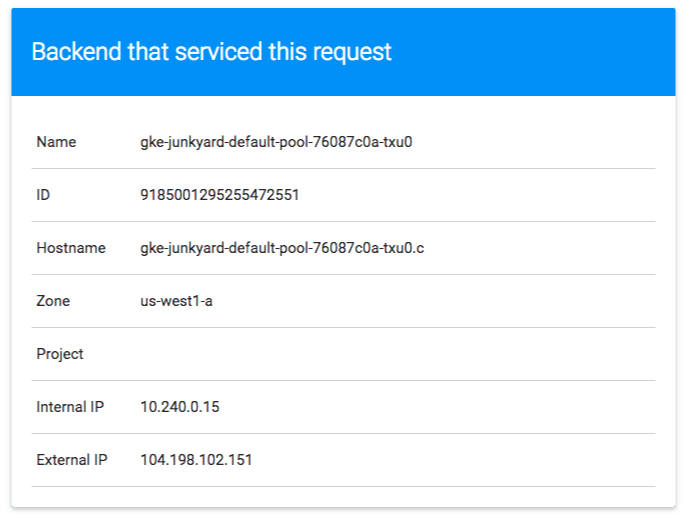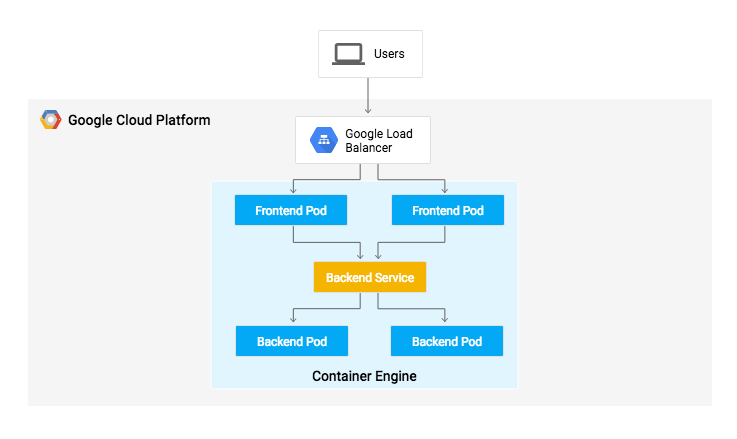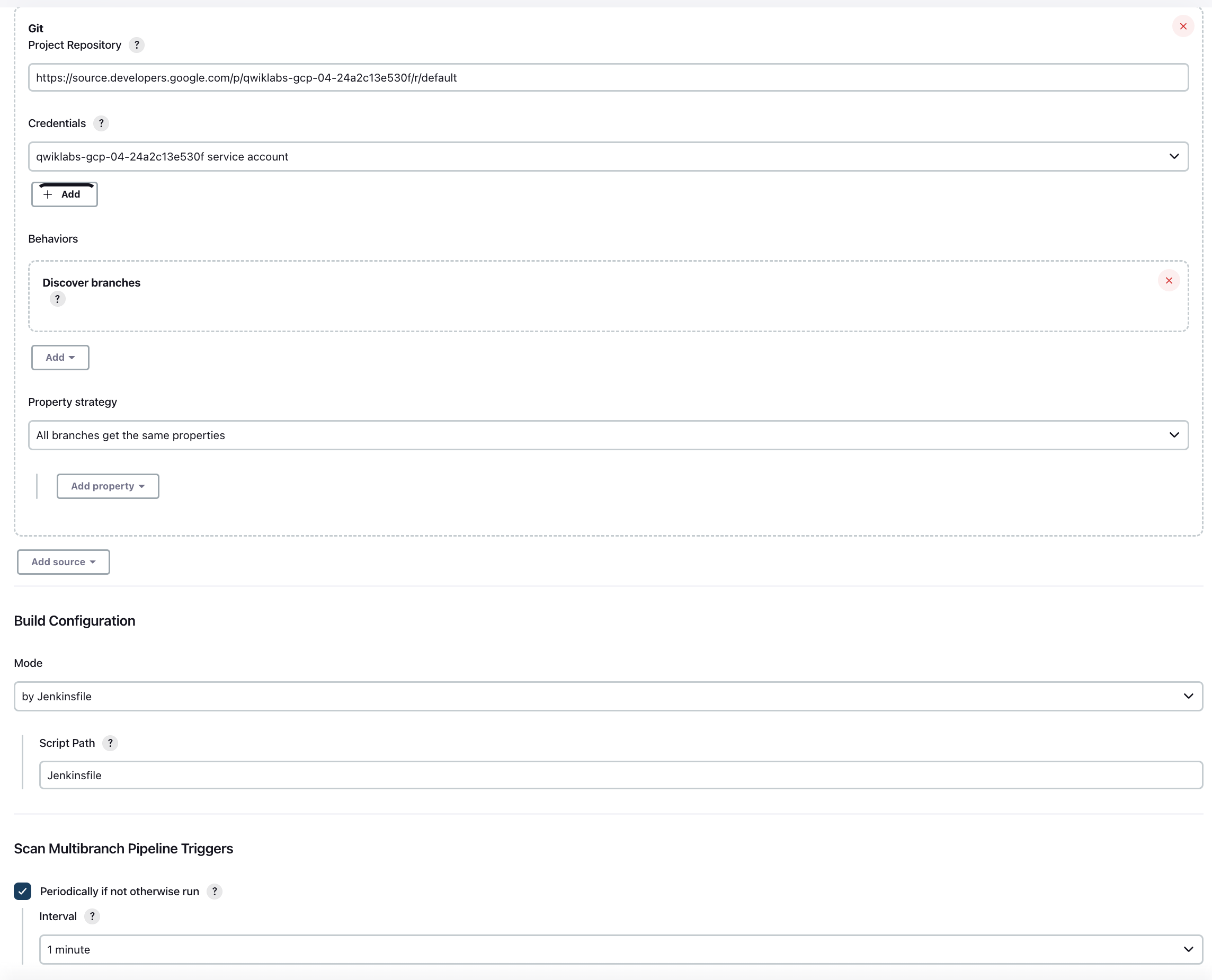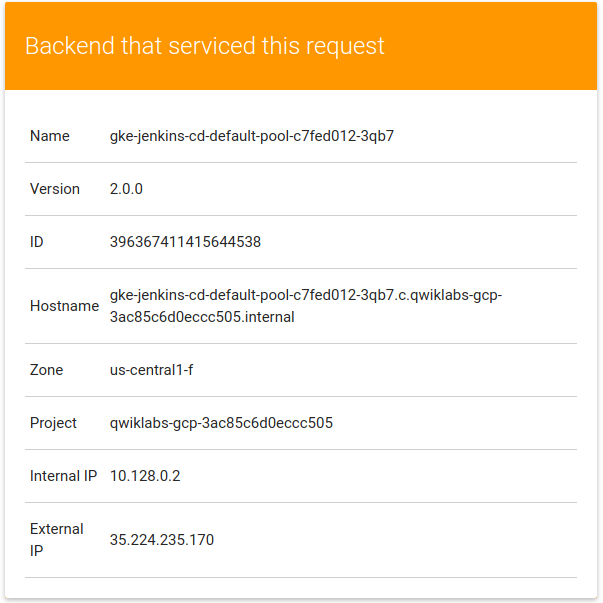Checkpoints
Create a Kubernetes cluster
/ 30
Configure and Install Jenkins
/ 20
Create the production and canary deployments
/ 30
Create a repository
/ 20
Continuous Delivery with Jenkins in Kubernetes Engine
- GSP051
- Overview
- Setup and requirements
- Task 1. Download the source code
- Task 2. Provisioning Jenkins
- Task 3. Setup Helm
- Task 4. Configure and Install Jenkins
- Task 5. Connect to Jenkins
- Task 6. Understanding the Application
- Task 7. Deploying the Application
- Task 8. Creating the Jenkins Pipeline
- Task 9. Creating the development environment
- Task 10. Kick off Deployment
- Task 11. Deploying a canary release
- Task 12. Deploying to production
- Task 13. Test your Understanding
- Congratulations!
GSP051
Overview
In this lab, you will learn how to set up a continuous delivery pipeline with Jenkins on Kubernetes engine. Jenkins is the go-to automation server used by developers who frequently integrate their code in a shared repository. The solution you'll build in this lab will be similar to the following diagram:
In the Cloud Architecture Center, see Jenkins on Kubernetes Engine to learn more about running Jenkins on Kubernetes.
What you'll learn
In this lab, you'll complete the following tasks to learn about running Jenkins on Kubernetes:
- Provision a Jenkins application into a Kubernetes Engine Cluster
- Set up your Jenkins application using Helm Package Manager
- Explore the features of a Jenkins application
- Create and exercise a Jenkins pipeline
Prerequisites
This is an advanced level lab. Before taking it, you should be comfortable with at least the basics of shell programming, Kubernetes, and Jenkins. Here are some labs that can get you up to speed:
- Introduction to Docker
- Hello Node Kubernetes
- Managing Deployments Using Kubernetes Engine
- Setting up Jenkins on Kubernetes Engine
Once you are prepared, scroll down to learn more about Kubernetes, Jenkins, and Continuous Delivery.
What is Kubernetes Engine?
Kubernetes Engine is Google Cloud's hosted version of Kubernetes - a powerful cluster manager and orchestration system for containers. Kubernetes is an open source project that can run on many different environments—from laptops to high-availability multi-node clusters; from virtual machines to bare metal. As mentioned before, Kubernetes apps are built on containers - these are lightweight applications bundled with all the necessary dependencies and libraries to run them. This underlying structure makes Kubernetes applications highly available, secure, and quick to deploy—an ideal framework for cloud developers.
What is Jenkins?
Jenkins is an open-source automation server that lets you flexibly orchestrate your build, test, and deployment pipelines. Jenkins allows developers to iterate quickly on projects without worrying about overhead issues that can stem from continuous delivery.
What is Continuous Delivery / Continuous Deployment?
When you need to set up a continuous delivery (CD) pipeline, deploying Jenkins on Kubernetes Engine provides important benefits over a standard VM-based deployment.
When your build process uses containers, one virtual host can run jobs on multiple operating systems. Kubernetes Engine provides ephemeral build executors—these are only utilized when builds are actively running, which leaves resources for other cluster tasks such as batch processing jobs. Another benefit of ephemeral build executors is speed—they launch in a matter of seconds.
Kubernetes Engine also comes pre-equipped with Google's global load balancer, which you can use to automate web traffic routing to your instance(s). The load balancer handles SSL termination and utilizes a global IP address that's configured with Google's backbone network—coupled with your web front, this load balancer will always set your users on the fastest possible path to an application instance.
Now that you've learned a little bit about Kubernetes, Jenkins, and how the two interact in a CD pipeline, it's time to go build one.
Setup and requirements
Before you click the Start Lab button
Read these instructions. Labs are timed and you cannot pause them. The timer, which starts when you click Start Lab, shows how long Google Cloud resources will be made available to you.
This hands-on lab lets you do the lab activities yourself in a real cloud environment, not in a simulation or demo environment. It does so by giving you new, temporary credentials that you use to sign in and access Google Cloud for the duration of the lab.
To complete this lab, you need:
- Access to a standard internet browser (Chrome browser recommended).
- Time to complete the lab---remember, once you start, you cannot pause a lab.
How to start your lab and sign in to the Google Cloud console
-
Click the Start Lab button. If you need to pay for the lab, a pop-up opens for you to select your payment method. On the left is the Lab Details panel with the following:
- The Open Google Cloud console button
- Time remaining
- The temporary credentials that you must use for this lab
- Other information, if needed, to step through this lab
-
Click Open Google Cloud console (or right-click and select Open Link in Incognito Window if you are running the Chrome browser).
The lab spins up resources, and then opens another tab that shows the Sign in page.
Tip: Arrange the tabs in separate windows, side-by-side.
Note: If you see the Choose an account dialog, click Use Another Account. -
If necessary, copy the Username below and paste it into the Sign in dialog.
{{{user_0.username | "Username"}}} You can also find the Username in the Lab Details panel.
-
Click Next.
-
Copy the Password below and paste it into the Welcome dialog.
{{{user_0.password | "Password"}}} You can also find the Password in the Lab Details panel.
-
Click Next.
Important: You must use the credentials the lab provides you. Do not use your Google Cloud account credentials. Note: Using your own Google Cloud account for this lab may incur extra charges. -
Click through the subsequent pages:
- Accept the terms and conditions.
- Do not add recovery options or two-factor authentication (because this is a temporary account).
- Do not sign up for free trials.
After a few moments, the Google Cloud console opens in this tab.

Activate Cloud Shell
Cloud Shell is a virtual machine that is loaded with development tools. It offers a persistent 5GB home directory and runs on the Google Cloud. Cloud Shell provides command-line access to your Google Cloud resources.
- Click Activate Cloud Shell
at the top of the Google Cloud console.
When you are connected, you are already authenticated, and the project is set to your Project_ID,
gcloud is the command-line tool for Google Cloud. It comes pre-installed on Cloud Shell and supports tab-completion.
- (Optional) You can list the active account name with this command:
- Click Authorize.
Output:
- (Optional) You can list the project ID with this command:
Output:
gcloud, in Google Cloud, refer to the gcloud CLI overview guide.
Task 1. Download the source code
- To get set up, open a new session in Cloud Shell and run the following command to set your zone
:
- Then copy the lab's sample code:
- Now change to the correct directory:
Task 2. Provisioning Jenkins
Creating a Kubernetes cluster
- Now, run the following command to provision a Kubernetes cluster:
This step can take up to several minutes to complete. The extra scopes enable Jenkins to access Cloud Source Repositories and Google Container Registry.
Test completed task
Click Check my progress to verify your performed task. If you have successfully created a Kubernetes cluster, you'll see an assessment score.
- Before continuing, confirm that your cluster is running by executing the following command:
- Now, get the credentials for your cluster:
- Kubernetes Engine uses these credentials to access your newly provisioned cluster—confirm that you can connect to it by running the following command:
Task 3. Setup Helm
In this lab, you will use Helm to install Jenkins from the Charts repository. Helm is a package manager that makes it easy to configure and deploy Kubernetes applications. Once you have Jenkins installed, you'll be able to set up your CI/CD pipeline.
- Add Helm's stable chart repo:
- Ensure the repo is up to date:
Task 4. Configure and Install Jenkins
When installing Jenkins, a values file can be used as a template to provide values that are necessary for setup.
You will use a custom values file to automatically configure your Kubernetes Cloud and add the following necessary plugins:
- Kubernetes:latest
- Workflow-multibranch:latest
- Git:latest
- Configuration-as-code:latest
- Google-oauth-plugin:latest
- Google-source-plugin:latest
- Google-storage-plugin:latest
This will allow Jenkins to connect to your cluster and your GCP project.
- Use the Helm CLI to deploy the chart with your configuration settings:
This command may take a couple minutes to complete.
Test completed task
Click Check my progress to verify your performed task. If you have successfully configured a Jenkins chart you will see an assessment score.
- Once that command completes ensure the Jenkins pod goes to the
Runningstate and the container is in the READY state:
Example Output:
- Configure the Jenkins service account to be able to deploy to the cluster:
You should receive the following output:
- Run the following command to setup port forwarding to the Jenkins UI from the Cloud Shell:
- Now, check that the Jenkins Service was created properly:
Example Output:
You are using the Kubernetes Plugin so that our builder nodes will be automatically launched as necessary when the Jenkins master requests them. Upon completion of their work, they will automatically be turned down and their resources added back to the cluster's resource pool.
Notice that this service exposes ports 8080 and 50000 for any pods that match the selector. This will expose the Jenkins web UI and builder/agent registration ports within the Kubernetes cluster. Additionally, the jenkins-ui service is exposed using a ClusterIP so that it is not accessible from outside the cluster.
Task 5. Connect to Jenkins
- The Jenkins chart will automatically create an admin password for you. To retrieve it, run:
- To get to the Jenkins user interface, click on the Web Preview button in Cloud Shell, then click Preview on port 8080:
- If asked, log in with username
adminand your auto-generated password.
You now have Jenkins set up in your Kubernetes cluster! Jenkins will drive your automated CI/CD pipelines in the next sections.
Task 6. Understanding the Application
You'll deploy the sample application, gceme, in your continuous deployment pipeline. The application is written in the Go language and is located in the repo's sample-app directory. When you run the gceme binary on a Compute Engine instance, the app displays the instance's metadata in an info card.
The application mimics a microservice by supporting two operation modes.
- In backend mode: gceme listens on port 8080 and returns Compute Engine instance metadata in JSON format.
- In frontend mode: gceme queries the backend gceme service and renders the resulting JSON in the user interface.
Task 7. Deploying the Application
You will deploy the application into two different environments:
- Production: The live site that your users access.
- Canary: A smaller-capacity site that receives only a percentage of your user traffic. Use this environment to validate your software with live traffic before it's released to all of your users.
- In Google Cloud Shell, navigate to the sample application directory:
- Create the Kubernetes namespace to logically isolate the deployment:
- Create the production and canary deployments, and the services using the
kubectl applycommands:
Test completed task
Click Check my progress to verify your performed task. If you have successfully created deployments you will see an assessment score.
By default, only one replica of the frontend is deployed. Use the kubectl scale command to ensure that there are at least 4 replicas running at all times.
- Scale up the production environment frontends by running the following command:
- Now confirm that you have 5 pods running for the frontend, 4 for production traffic and 1 for canary releases (changes to the canary release will only affect 1 out of 5 (20%) of users):
- Also confirm that you have 2 pods for the backend, 1 for production and 1 for canary:
- Retrieve the external IP for the production services:
Example Output:
Paste External IP into a browser to see the info card displayed on a card—you should get a similar page:
- Now, store the frontend service load balancer IP in an environment variable for use later:
-
Confirm that both services are working by opening the frontend external IP address in your browser.
-
Check the version output of the service by running the following command (it should read 1.0.0):
You have successfully deployed the sample application! Next, you will set up a pipeline for deploying your changes continuously and reliably.
Task 8. Creating the Jenkins Pipeline
Creating a repository to host the sample app source code
- Create a copy of the
gcemesample app and push it to a Cloud Source Repository:
You can ignore the warning, you will not be billed for this repository.
Test completed task
Click Check my progress to verify your performed task. If you have successfully created a source repository you will see an assessment score.
- Initialize the sample-app directory as its own Git repository:
- Run the following command:
- Set the username and email address for your Git commits. Replace
[EMAIL_ADDRESS]with your Git email address and[USERNAME]with your Git username:
- Add, commit, and push the files:
Adding your service account credentials
Configure your credentials to allow Jenkins to access the code repository. Jenkins will use your cluster's service account credentials in order to download code from the Cloud Source Repositories.
-
In the Jenkins user interface, click Manage Jenkins in the left navigation then click Security > Credentials.
-
Click System.
-
Click Global credentials (unrestricted).
-
Click Add Credentials in the top right corner.
-
Select Google Service Account from metadata from the Kind drop-down and click Create.
The global credentials have been added. The name of the credential is the Project ID found in the CONNECTION DETAILS section of the lab.
Configure Jenkins Cloud for Kubernetes
- In the Jenkins user interface, select Manage Jenkins > Nodes.
- Click Clouds in the left navigation pane.
- Click New cloud.
- Type any name under Cloud name and then select Kubernetes for Type.
- Click Create.
- Click Kubernetes Cloud Details.
- In the Jenkins URL field, enter the following value:
http://cd-jenkins:8080 - In the Jenkins tunnel field, enter the following value:
cd-jenkins-agent:50000 - Click Save.
Creating the Jenkins job
Navigate to your Jenkins user interface and follow these steps to configure a Pipeline job.
-
Click Dashboard > New Item in the left panel.
-
Name the project sample-app, then choose the Multibranch Pipeline option and click OK.
-
On the next page, in the Branch Sources section, select Git from Add Source dropdown.
-
Paste the HTTPS clone URL of your sample-app repo in Cloud Source Repositories into the Project Repository field. Replace
[PROJECT_ID]with your Project ID:
-
From the Credentials drop-down, select the name of the credentials you created when adding your service account in the previous steps.
-
Under Scan Multibranch Pipeline Triggers section, check the Periodically if not otherwise run box and set the Interval value to 1 minute.
-
Your job configuration should look like this:
- Click Save leaving all other options with their defaults.
After you complete these steps, a job named Branch indexing runs. This meta-job identifies the branches in your repository and ensures changes haven't occurred in existing branches. If you click sample-app in the top left, the master job should be seen.
You have successfully created a Jenkins pipeline! Next, you'll create the development environment for continuous integration.
Task 9. Creating the development environment
Development branches are a set of environments your developers use to test their code changes before submitting them for integration into the live site. These environments are scaled-down versions of your application, but need to be deployed using the same mechanisms as the live environment.
Creating a development branch
To create a development environment from a feature branch, you can push the branch to the Git server and let Jenkins deploy your environment.
- Create a development branch and push it to the Git server:
Modifying the pipeline definition
The Jenkinsfile that defines that pipeline is written using the Jenkins Pipeline Groovy syntax. Using a Jenkinsfile allows an entire build pipeline to be expressed in a single file that lives alongside your source code. Pipelines support powerful features like parallelization and require manual user approval.
In order for the pipeline to work as expected, you need to modify the Jenkinsfile to set your project ID.
- Open the Jenkinsfile in your terminal editor, for example
vi:
- Start the editor:
-
Add your
PROJECT_IDto theREPLACE_WITH_YOUR_PROJECT_IDvalue. (YourPROJECT_IDis your Project ID found in theCONNECTION DETAILSsection of the lab. You can also rungcloud config get-value projectto find it. -
Change the value of
CLUSTER_ZONEto. You can get this value by running gcloud config get compute/zone.
- Save the
Jenkinsfilefile: hit Esc then (forviusers):
Modify the site
To demonstrate changing the application, you will change the gceme cards from blue to orange.
- Open
html.go:
- Start the editor:
- Change the two instances of
<div class="card blue">with following:
- Save the
html.gofile: press Esc then:
- Open
main.go:
- Start the editor:
- The version is defined in this line:
Update it to the following:
- Save the main.go file one more time: Esc then:
Task 10. Kick off Deployment
- Commit and push your changes:
This will kick off a build of your development environment.
After the change is pushed to the Git repository, navigate to the Jenkins user interface where you can see that your build started for the new-feature branch. It can take up to a minute for the changes to be picked up.
- After the build is running, click the down arrow next to the build in the left navigation and select Console output:
- Track the output of the build for a few minutes and watch for the
kubectl --namespace=new-feature apply...messages to begin. Your new-feature branch will now be deployed to your cluster.
If you didn't see anything in Build Executor, not to worry. Just go to the Jenkins homepage > sample app. Verify that the new-feature pipeline has been created.
- Once that's all taken care of, start the proxy in the background:
- If it stalls, press Ctrl + C to exit out. Verify that your application is accessible by sending a request to
localhostand lettingkubectlproxy forward it to your service:
You should see it respond with 2.0.0, which is the version that is now running.
If you receive a similar error:
- It means your frontend endpoint hasn't propagated yet—wait a little bit and try the
curlcommand again. Move on when you get the following output:
You have set up the development environment! Next, you will build on what you learned in the previous module by deploying a canary release to test out a new feature.
Task 11. Deploying a canary release
You have verified that your app is running the latest code in the development environment, so now deploy that code to the canary environment.
- Create a canary branch and push it to the Git server:
- In Jenkins, you should see the canary pipeline has kicked off. Once complete, you can check the service URL to ensure that some of the traffic is being served by your new version. You should see about 1 in 5 requests (in no particular order) returning version
2.0.0.
- If you keep seeing 1.0.0, try running the above commands again. Once you've verified that the above works, end the command with Ctrl + C.
That's it! You have deployed a canary release. Next you will deploy the new version to production.
Task 12. Deploying to production
Now that our canary release was successful and we haven't heard any customer complaints, deploy to the rest of your production fleet.
- Create a canary branch and push it to the Git server:
In Jenkins, you should see the master pipeline has kicked off.
- Once complete (which may take a few minutes), you can check the service URL to ensure that all of the traffic is being served by your new version, 2.0.0.
- Once again, if you see instances of
1.0.0try running the above commands again. You can stop this command by pressing Ctrl + C.
Example output:
You can also navigate to site on which the gceme application displays the info cards. The card color changed from blue to orange.
- Here's the command again to get the external IP address. Paste the External IP into a new tab to see the info card displayed:
Example output:
Task 13. Test your Understanding
Below are multiple-choice questions to reinforce your understanding of this lab's concepts. Answer them to the best of your abilities.
You're done!
Awesome job, you have successfully deployed your application to production!
Congratulations!
This concludes this hands-on lab deploying and working with Jenkins in Kubernetes Engine to enable a Continuous Delivery / Continuous Deployment pipeline. You've had the opportunity to deploy a significant DevOps tool in Kubernetes Engine and configure it for production use. You've worked with the kubectl command-line tool and deployment configurations in YAML files, and have learned a bit about setting up Jenkins pipelines for a development / deployment process. With this practical hands-on experience you should feel comfortable applying these tools in your own DevOps shop.
Finish your quest
This self-paced lab is part of the Kubernetes in the Google Cloud, Cloud Architecture, and DevOps Essentials quests. A quest is a series of related labs that form a learning path. Completing a quest earns you a badge to recognize your achievement. You can make your badge or badges public and link to them in your online resume or social media account. Enroll in any quest that contains this lab and get immediate completion credit. See the Google Cloud Skills Boost catalog to see all available quests.
Take your next lab
Continue your quest with Hello Node Kubernetes, or check out these Google Cloud Skills Boost labs:
Next steps / Learn more
- Read further on the Jenkins in Kubernetes Engine Solution.
- Learn how to use Jenkins to enable Continuous Delivery to Kubernetes Engine.
- Read further on DevOps Solutions and DevOps Guides in the Google Cloud documentation.
- Connect with the Jenkins Community!
Google Cloud training and certification
...helps you make the most of Google Cloud technologies. Our classes include technical skills and best practices to help you get up to speed quickly and continue your learning journey. We offer fundamental to advanced level training, with on-demand, live, and virtual options to suit your busy schedule. Certifications help you validate and prove your skill and expertise in Google Cloud technologies.
Manual Last Updated September 20, 2023
Lab Last Tested September 20, 2023
Copyright 2024 Google LLC All rights reserved. Google and the Google logo are trademarks of Google LLC. All other company and product names may be trademarks of the respective companies with which they are associated.










